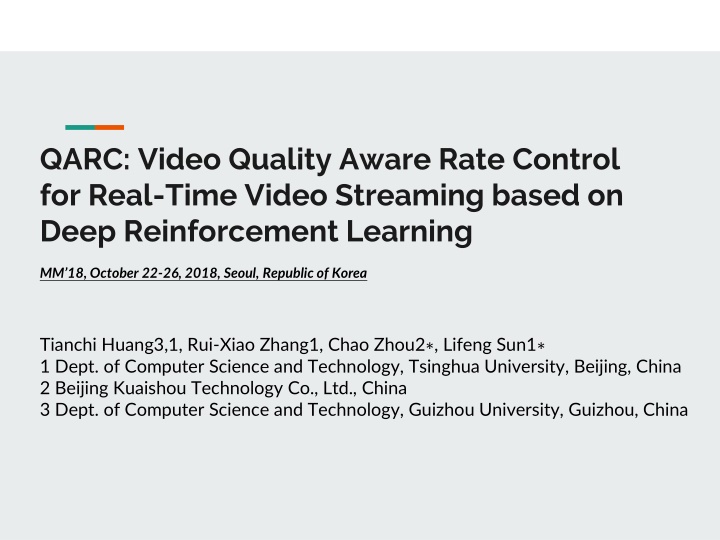
Video Quality Aware Rate Control for Real-Time Video Streaming
This paper introduces a deep reinforcement learning-based approach to optimize the sending bitrate for real-time video streaming, focusing on maximizing video quality. The system architecture includes a Video Quality Prediction Network (VQPN) and Video Quality Reinforcement Learning (VQRL) components for efficient bitrate selection.
Download Presentation

Please find below an Image/Link to download the presentation.
The content on the website is provided AS IS for your information and personal use only. It may not be sold, licensed, or shared on other websites without obtaining consent from the author. If you encounter any issues during the download, it is possible that the publisher has removed the file from their server.
You are allowed to download the files provided on this website for personal or commercial use, subject to the condition that they are used lawfully. All files are the property of their respective owners.
The content on the website is provided AS IS for your information and personal use only. It may not be sold, licensed, or shared on other websites without obtaining consent from the author.
E N D
Presentation Transcript
QARC: Video Quality Aware Rate Control for Real-Time Video Streaming based on Deep Reinforcement Learning MM 18, October 22-26, 2018, Seoul, Republic of Korea Tianchi Huang3,1, Rui-Xiao Zhang1, Chao Zhou2 , Lifeng Sun1 1 Dept. of Computer Science and Technology, Tsinghua University, Beijing, China 2 Beijing Kuaishou Technology Co., Ltd., China 3 Dept. of Computer Science and Technology, Guizhou University, Guizhou, China
Introduction - This paper proposes the DRL-based approach to select sending bitrate in real-time video streaming. Different previous work, this work tries to maximize video quality rather from than bitrate. They derive the neural network into two parts to reduce state space: - First part: a neural network used to precisely predict future video quality based on the previous video frames - Second part: an RL model used to determine the proper bitrate based on the output of the first model. - -
Motivation - In real-time live streaming scenario, high video bitrate is equaled to high video quality. However, in some siuation, high video quality only requires a low bitrate. - => If making the right decision, it can save a lot of bandwidth.
System Architecture - There are two part in their propose method: - Video Quality Prediction Network (VQPN) predicts the future video quality metrics based on historical video frames - Video Quality Reinforcement Learning (VQRL) select bitrates for future video frames based on network status observations and the future video quality metrics predicted by VQPN.
VQPN - Input: historical video frames (Fi = [fi k , fi k+1, , fi ]) Output: prediction of the video quality assessment in the next time slot t + 1 of candidate bitrates Loss function: (MSE with regulation) - - - - Using CNN to extract feature Using a double-layered recurrent layer [5] to extract temporal characteristics of the video frames Fi in past k sequences [5] Junyoung Chung, Caglar Gulcehre, Kyunghyun Cho, and Yoshua Bengio. 2014. Empirical Evaluation of Gated Recurrent Neural Networks on Sequence Modeling. arXiv: Neural and Evolutionary Computing (2014).
VQRL - - Using A3C algorithm [21] State: - Reward: QoE [20] (N: time slot, V: video quality, B:bitrate, D:delay gradient) [20]Hongzi Mao, Ravi Netravali, and Mohammad Alizadeh. 2017. Neural adaptive video streaming with pensieve. In Proceedings of the Conference of the ACM Special Interest Group on Data Communication. ACM, 197 210. [21] Volodymyr Mnih, Adria Puigdomenech Badia, Mehdi Mirza, Alex Graves, Timothy Lillicrap, Tim Harley, David Silver, and Koray Kavukcuoglu. 2016. Asynchronous methods for deep reinforcement learning. In International Conference on Machine Learning. 1928 1937.
Evaluation - setup - Video dataset: - VideoSet: a large-scale compressed video quality dataset based on JND measurement - self-collected: involves live-casts, music-videos, and some short movies. Network traces: - Packet-level network traces - Chunk-level network traces - Synthetic network traces: using a Markovian model where each state represented an - average throughput in the aforementioned range[20] Metric: - QoE - Video quality (VMAF, and normalize in [0,1]) - Sending bitrate (Mbps) - Queuing delay (s) - - [20]Hongzi Mao, Ravi Netravali, and Mohammad Alizadeh. 2017. Neural adaptive video streaming with pensieve. In Proceedings of the Conference of the ACM Special Interest Group on Data Communication. ACM, 197 210.
Evaluation - baseline - QARC can achieve good video quality, high bitrate and low delay in the same time. with improvements in average video quality of 18% - 25% and decreases in average queuing delay of 23% - 45%. QARC v.s. Compund TCP - -
Evaluation - coefficient , , and - Initialize QoE reward with small latency coefficient yield high- performance improvement over the one with a bigger in wired network conditions However, in 4G network environments, it performs a very different performance. -
Conclusion - Propose a RL-based rate control algorithm in the real-time video streaming scenario Try to get a higher video quality with possibly lower sending rate. To reduce the state space of the RL model, we derive the neural network into two parts and train them respectively QARC outperforms existing rate control algorithms - - -
